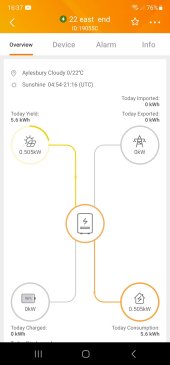Hi
I have a complicated system (?) as I dont have roof space for 12 panels so they have been split over the garage roof and house roof. Each string on panels having a dedicated Solis S5 invertor and Fox 5200 battery (therefore I have 2 independant but connected systems - one on garage roof and one on house roof). Im told that the garage system will feed power back to the house circuit as needed via the AC cable but the batteries for each string are independant (I understand and accept the compromise or splitting the batteries out and avoiding a DC feed being run from the garage back to the house and having a single invertor and battery set up)
The set up on the house roof works fine and the battery icon on the Solis App is purple, the battery charges from PV and grid fine and discharges fine. Job done.
The garage string will charge from the grid but wont discharge on demand. The icon on the app for the battery is grey. I have checked settings on both invertors and they appear the same. The only way I can get the battery to discharge is to set up the invertor to discharge to grid and drain the battery to the grid ... which shows that the invertor can at least drain the battery...but clearly not how its needed to work...i.e. to support demand from the house.
From a App perspective I have 2 seperate system accounts with each invertor talking to my wifi independantly via a dongle
any thoughts anyone? does anyone know the significance of the battery icon colours?
thanks in advance
I have a complicated system (?) as I dont have roof space for 12 panels so they have been split over the garage roof and house roof. Each string on panels having a dedicated Solis S5 invertor and Fox 5200 battery (therefore I have 2 independant but connected systems - one on garage roof and one on house roof). Im told that the garage system will feed power back to the house circuit as needed via the AC cable but the batteries for each string are independant (I understand and accept the compromise or splitting the batteries out and avoiding a DC feed being run from the garage back to the house and having a single invertor and battery set up)
The set up on the house roof works fine and the battery icon on the Solis App is purple, the battery charges from PV and grid fine and discharges fine. Job done.
The garage string will charge from the grid but wont discharge on demand. The icon on the app for the battery is grey. I have checked settings on both invertors and they appear the same. The only way I can get the battery to discharge is to set up the invertor to discharge to grid and drain the battery to the grid ... which shows that the invertor can at least drain the battery...but clearly not how its needed to work...i.e. to support demand from the house.
From a App perspective I have 2 seperate system accounts with each invertor talking to my wifi independantly via a dongle
any thoughts anyone? does anyone know the significance of the battery icon colours?
thanks in advance




